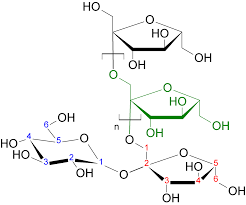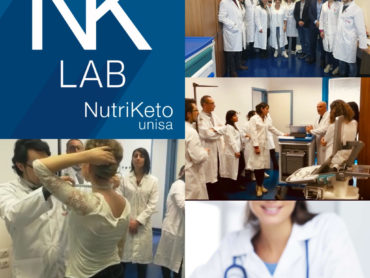Inulin is a fructan, a plant-based polysaccharide used as a reserve substance in some plants, mainly from the Asteraceae family, and which has interesting food and pharmaceutical applications.
Inulin is present in more than 30,000 plant species, among the best known sources the tubers of Helianthus tuberosus, Cichorium intybus, Dahlia pinnata and Polymnia sonchifolia (Braz de Oliveira et al., 2011
It was discovered in the early 1800s by the German chemist Valentine Rose, as a source of carbohydrates in the leaves of Inula helenium, and only later, in 1817, was named by the English scientist Thomson inulin. In 1864, the plant physiologist Julius Sachs, using a microscope, was able to detect inulin spherocrystals in the tubers of D. pinnata, H. tuberosus and I. helenium after having precipitated it with ethanol (Franck & De Leenheer, 2005) . Inulin is a mixture of oligo and / or polysaccharides composed of fructose units with beta configuration of the anomeric carbon, fructose is almost totally bound by β- (1 → 2) fructosyl-fructose bonds, which makes it resistant to hydrolysis of intestinal digestive enzymes and makes it classifiable as non-digestible oligosaccharide. The types of glycosidic bounds found in both oligomeric and polymeric plants (from two to one hundred fructose units), are dependent species and related to the environmental conditions and the state of development of the plant, the harvesting period and the extraction procedures (Barclay et al., 2010). Inulin can be hydrolyzed by an enzyme, the inulinase that can attack the substrate in two ways: at the tail of the inulin molecule (exo-inulinase), removing the terminal fructose residues or in a central area (endo-inulinase ) acting on internal bonds (Braz de Oliveira et al., 2011). Inulin acts similarly to dietary fiber and helps to improve the conditions of the gastrointestinal system. It resists digestion in the stomach and small intestine while it is hydrolyzed and fermented by the beneficial bacteria of the colon (lactobacilli and bifidobacteria), stimulating its growth, through the short-chain fatty acids (acetic, propionic and butyric) produced by fermentation, to the detriment of pathogenic microorganisms (colibacilli and clostridia). For these properties directed to the development of beneficial micro-organisms (probiotic microorganisms), inulin is considered a prebiotic food. Furthermore, recent studies have shown the ability of inulin to indirectly facilitate the absorption of water and some minerals in ionized form, in particular calcium and magnesium, thus exerting an interesting positive action towards the prevention of osteoporosis (Weaver, 2005 ). Among the properties that are attributed to inulin, there is also that of facilitating digestion and reducing intestinal gas by increasing the presence of useful bifidobacteria. Other possible effects are the reduction of blood cholesterol and the reduction of the blood concentration of triglycerides in subjects with poor diet. It does not increase blood sugar and is also suitable for diabetics. Among the possible pharmaceutical applications is used to modulate the functions of the colon and reduce the risk of certain diseases related to the metabolic syndrome. Thanks to these properties, the food and pharmaceutical industries have found applications of inulin and its derivatives as fructooligosaccharides (FOS) in the production of functional foods, nutritional compounds and drugs (Barclay et al., 2012). The best known source of FOS is the inulin from which they are extracted by enzymatic hydrolysis.
Another interest of the scientific world regarding inulin is that it can be used as a technological and food ingredient. Particular interest has aroused its use in the food industry as a total or partial substitute of fats and / or emulsifiers in food. It also has a thickening and volumizing action useful for the preparation of numerous recipes, in particular those of bakery products, ice cream, sweet and savory pastries. Inulin has a neutral taste and has no impact on sensory properties.
Many patents have been granted that guarantee the use of these fructans, as raw material for various purposes (Narvávez-Zapata et al., 2009).
This thesis emphasizes the chemical and structural aspects of inulin, the botanical sources, its extraction methods, purification and analysis, the biological significance of these molecules as prebiotic and, and potential applications in technological processes for food production reduced fat.
Literature
- Barclay, T., Ginic-Markovic, M., Cooper, P. and Petrovsky N., (2010), Inulin: a versatile polysaccharide with multiple pharmaceutical and food chemical uses, Journal of Excipients and Food Chemical, 1, 27-50.
- Barclay, T., Ginic-Markovic, M., Johnston, M., Cooper, P. and Petrovsky N., (2012), Analysis of the hydrolysis of inulin using real time H-1 NMR spectroscopy, Carbohydrate Research, 352, 117-125.
- Braz de Oliveira, A., Correia Goncalves, R.A., Cantuaria Chierrito, T.P., dos Santos, M.M., de Souza, L.M. and James Gorin P.A., (2011), Structure and degree of polymerisation of fructooligosaccharides preent in roots and levans of Stevia rebaudiana (Bert.) Bertoni, Food Chemistry, 129, 305-311
- Franck, A., (2002), Technological functionality of inulin and oligofructose, British Journal of Nutrition, 87, 287-291
- Narvavez-Zapata, J.A. and Sanchez-Teyer F., (2009) Agave as a raw material, recent technologies and application, Recent Patents on Biotechnology, 3, 185-191









